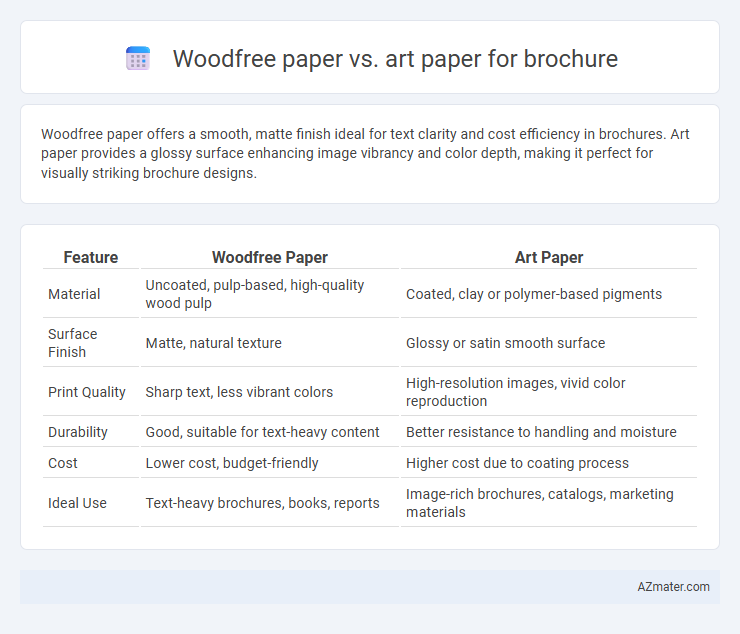Woodfree paper offers a smooth, matte finish ideal for text clarity and cost efficiency in brochures. Art paper provides a glossy surface enhancing image vibrancy and color depth, making it perfect for visually striking brochure designs.
Table of Comparison
| Feature | Woodfree Paper | Art Paper |
|---|---|---|
| Material | Uncoated, pulp-based, high-quality wood pulp | Coated, clay or polymer-based pigments |
| Surface Finish | Matte, natural texture | Glossy or satin smooth surface |
| Print Quality | Sharp text, less vibrant colors | High-resolution images, vivid color reproduction |
| Durability | Good, suitable for text-heavy content | Better resistance to handling and moisture |
| Cost | Lower cost, budget-friendly | Higher cost due to coating process |
| Ideal Use | Text-heavy brochures, books, reports | Image-rich brochures, catalogs, marketing materials |
Introduction to Brochure Paper Choices
Woodfree paper offers a smooth, bright surface ideal for high-quality text printing in brochures, enhancing readability and professional appeal. Art paper, coated with a glossy or matte finish, provides vibrant color reproduction and a premium look, perfect for image-rich brochures. Choosing between woodfree and art paper depends on desired print quality, budget, and the brochure's visual focus.
What is Woodfree Paper?
Woodfree paper is a high-quality printing material made from chemical pulp that has had lignin removed, resulting in a smoother and brighter surface ideal for text-heavy brochures. Unlike art paper, which is coated and often glossy to enhance images and visual appeal, woodfree paper provides excellent print clarity, durability, and a natural matte finish. This makes woodfree paper a popular choice for brochures requiring sharp typography and minimized ink absorption.
What is Art Paper?
Art paper is a high-quality coated paper known for its smooth, glossy finish and vibrant color reproduction, making it ideal for brochures requiring sharp images and vivid graphics. Unlike woodfree paper, which is uncoated and has a natural, matte texture, art paper enhances visual appeal through a polished surface that resists ink absorption and prevents smudging. Its superior brightness and opacity ensure that brochure designs stand out with professional clarity and durability.
Key Differences Between Woodfree and Art Papers
Woodfree paper, made from chemical pulp with minimal lignin, offers a smooth, matte finish ideal for high-volume brochures requiring affordability and sharp text clarity. Art paper, coated with clay or polymers, provides a glossy or satin surface that enhances image vibrancy and color precision, making it perfect for visually rich brochures. The primary differences lie in their texture, print quality, and cost, with woodfree paper excelling in readability and art paper in image reproduction.
Print Quality Comparison
Woodfree paper offers a smooth, non-coated surface that provides sharp text clarity but lacks the vibrant color reproduction of art paper. Art paper, often coated with a clay or polymer layer, delivers superior print quality with enhanced color saturation and finer image detail, making it ideal for high-end brochures. The choice depends on whether crisp readability or striking visual appeal is the priority for the printed material.
Visual Appeal and Texture
Woodfree paper offers a clean, bright white surface that enhances sharp image reproduction, making it ideal for brochures requiring clarity and professional visual appeal. Art paper features a smooth, coated texture that provides a glossy or matte finish, enriching color vibrancy and tactile experience for high-end brochure designs. Choosing between woodfree and art paper depends on the desired balance of texture softness and striking visual impact in brochure presentation.
Durability and Longevity
Woodfree paper, made from chemically processed pulp, offers moderate durability and is prone to yellowing over time, reducing its longevity for brochures. Art paper, coated with clay or other materials, provides superior resistance to moisture, fading, and physical wear, ensuring longer-lasting print quality and durability. For brochures requiring extended lifespan and frequent handling, art paper is the preferred choice due to its enhanced strength and archival properties.
Cost Considerations
Woodfree paper offers an economical option for brochures due to its lower production costs and natural uncoated finish, making it ideal for large print runs on a budget. Art paper, featuring a coated surface and higher brightness, increases brochure costs but enhances image quality and color vibrancy, which is valuable for premium marketing materials. Choosing between woodfree and art paper ultimately depends on balancing budget constraints against the desired visual impact and durability of the brochure.
Best Applications for Woodfree and Art Paper
Woodfree paper, characterized by its smooth, high opacity and excellent printing surface, is best suited for brochures requiring sharp text, clear images, and a professional look, ideal for corporate reports, financial documents, and text-heavy materials. Art paper, with its glossy or matte coated finish and superior color reproduction, excels in brochures featuring vibrant graphics, photographs, and marketing materials for fashion, photography, or luxury brands. Choosing woodfree paper enhances readability and durability, while art paper maximizes visual impact through rich colors and texture variety.
How to Choose the Right Paper for Your Brochure
Choosing the right paper for your brochure depends on the desired finish and durability; woodfree paper offers a smooth, matte surface ideal for text-heavy, professional documents, while art paper provides a glossy or satin finish that enhances vibrant images and colors. Consider the purpose of your brochure: woodfree paper is cost-effective and suitable for mass distribution, whereas art paper elevates brand perception with a premium feel, making it perfect for high-end promotions. Evaluate factors like print quality, budget, and target audience to select a paper that reinforces your message and complements your design.

Infographic: Woodfree paper vs Art paper for Brochure
 azmater.com
azmater.com